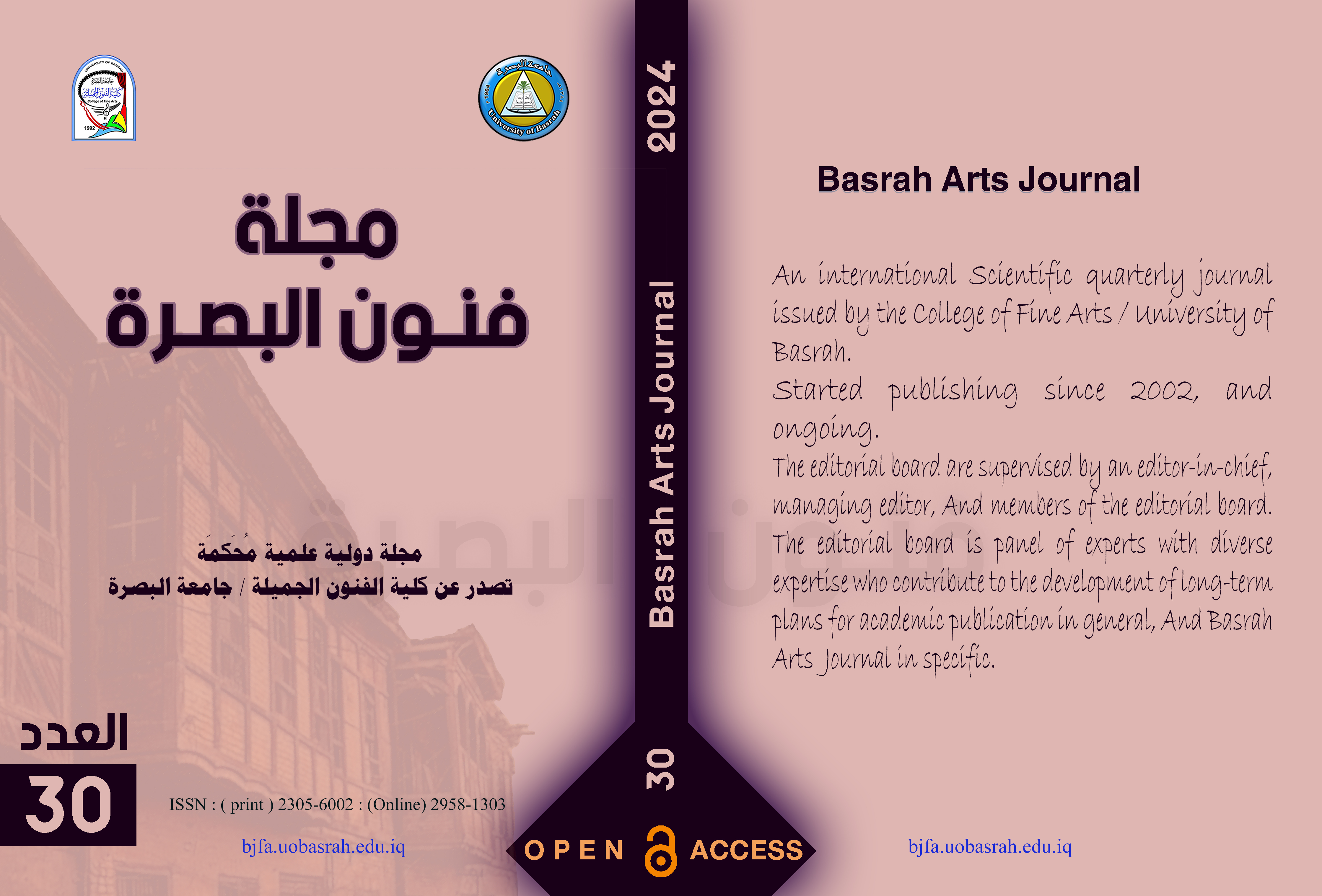The effect of the illusioned image in representing the historical facts
Iraqi painting as an example
DOI:
https://doi.org/10.59767/2024.08/30.3Keywords:
imagined imag, historical facts, Iraqi paintingAbstract
The research was conducted tagged (the effect of the imagined image in the representation of historical facts - Iraqi painting as a model) to identify the most important historical facts and their artistic treatments in Iraqi painting, and therefore this study was built on four chapters: the first chapter (the general framework of the research): included the research problem that ended with the following question: How is the image of the scene that the artist wants to record if it is realistic or unrealistic The importance of the research and the need for it, as well as the purpose of the research and the limits of the research, and then the identification and definition of the terms contained in the title linguistically, terminologically and procedurally, as for the second chapter (theoretical framework and previous studies): it included two researchers, the first research: the concept of the imagined image, and the second research: The third chapter (research procedures): the research community and its sample, the research tool, and the analysis of the research sample included three paintings, and the fourth chapter included: the results, their discussion and conclusions, and the following are some of the results:
- That the artist expresses realistic historical facts recorded with perceptions far from realistic forms as an attempt to show the depth of meaning and importance of the incident.
2. The artist succeeded in making the recipient follow from the first moment to realize the nature of the work and the nature of the subject presented to him by the artist through the painting; which means that the artist was aware of the connotations that his paintings give about the embodiment of the incident and its documentation.
References
Abbas, M. A., & Al-kinani, A. A. (2022). Intellectual Implications of the Duality of Mother and Child in the Social Perspective. Journal for Educators, Teachers and Trainers(4), pp. 229–237. doi:https://doi.org/10.47750/jett.2022.13.04.032
Abdel Hamid, S. (2009). Imagination “From the Cave to Virtual Reality”. Kuwait: World of Knowledge Series, National Council for Culture, Arts and Literature.
Abdul Hamid, S. (2005). The Age of Images - Negatives and Positives. Kuwait: World of Knowledge.
Abu Rayyan, M. A. (n.d.). The Philosophy of Beauty and the Origins of Fine Arts. Alexandria, Egypt: University Knowledge House.
Al-Bahnasi, A. (1973). Revolution and Art, Ministry of Information. Damascus, Syria: Directorate of General Culture.
Aldaghlawy, H. J. (2021). color connotations with costumes in the performances of the school theater. Oman: Cambridge Scientific Journal. doi:https://doi.org/10.5281/zenodo.7787343
Al-Masry, K. (1976). The History of Art in Antiquity (Vol. 1st edition). Cairo, Egypt: Dar Al-Maaref.
Al-Zaidi, J. (2010). The Phenomenology of Visual Discours (Vol. 1st edition). Damascus, Syria: The Phenomenology of Visual Discourse,.
Asfour, J. (1974). The Artistic Image in the Critical and Rhetorical Heritage. Cairo, Egypt: House of Culture for Printing and Publishing.
Aumon, J. (2001). he Photo. (R. Al-Khoury, Ed.) Beirut, Lebanon: Arab Organization for Translation.
Barrow, A. (1977). Sumer, its Arts and Civilization. (I. Salman, & S. T. Al-Tikriti, Eds.) Baghdad, Iraq: Al-Hurriya Printing House.
Benkarad, S. (2005). Semiotics and Interpretation, Introduction to Semiotics (Vol. 1st edition). Beirut, Lebanon: Arab Cultural Center.
Deleuze, G. (1997). The Image - Movement or the Philosophy of the Image. (H. Odeh, Ed.) Damascus, Syria: Syrian Ministry of Culture.
Derain, A. (1994). Lettres a Vlaminck. Flammarion, Paris: followed by Correspondence de guerre, Flammarion.
Freud, S. (1969). The Interpretation of Dreams (Vol. 2nd edition). (M. Safwan, Ed.) Cairo, Egypt: Dar Al-Maaref.
Freud, S. (1983). Landmarks of Psychoanalysis (Vol. 5th edition). (M. O. Najati, Ed.) Algeria: Diwan of University Publications.
Friedman, N. (1976). The Artistic Image. (A. Jaber, Trans.) Baghdad, Iraq: House of General Cultural Affairs, Contemporary Writers Magazine.
Gachev, G. (1990). Consciousness and Art. (N. Nayouf, Trans.) Kuwait: Al-Resala Press.
Harbi, S. (2014). Styles and Trends in Ancient Egyptian Art. Cairo, Egypt: Egyptian General Book Authority.
Hegel. (1988). Introduction to Aesthetics, The Idea of Beauty (Vol. 3rd edition). (G. Tarabishi, Ed.) Beirut, Lebanon: Dar Al-Tali’ah for Printing and Publishing.
Jaber, A. (1974). The Artistic Image in the Critical and Rhetorical Heritage. Cairo, Egypt: House of Culture for Printing and Publishing.
Karam, Y. (2012). The History of Greek Philosophy. Cairo, Egypt: Hindawi Foundation for Education and Culture.
Levy, B. (ed). Primitive Mentality. (M. Al-Qassas, Ed.) Cairo, Egypt: Library of Egypt.
Mahmoud, A. H. (2021). he Synthetic Image in the Art of Mass Surrealism. Basrah, Iraq: University of Basra, College of Fine Arts.
Manzur, I. (1994). Lisan al-Arab. Beirut, Lebanon: Dar Sader.
Neumayer, S. (1972). The Story of Modern Art. (R. Younan, Ed.) Cairo, Egypt: Contemporary Thought Series.
Omar, A. M. (2008). Dictionary of the Contemporary Arabic Language (Vol. 1st edition). Cairo, Egypt: Alam al-Kutub.
Parmenides, P. (1976). (F. J. Barbara, Ed.) Damascus, Syria: Ministry of Culture.
Qasim, H. S. (2013). Fantasy in Contemporary European Painting, an analytical study in the formation of the imagined image. Basra, Iraq: unpublished master’s thesis.
Ross, M. E. (2003). Salvador Dali and the Surrealists (Vol. First edition). Chicago Review Press.
Salbia, J. (1982). The Philosophical Dictionary (Vol. 1st edition). Beirut, Lebanon: Lebanese Book House.
Salbia, J. (1982). The Philosophical Dictionary of Arabic, French, English, and Latin Words. Beirut, Lebanon: Lebanese Book House.
Saliba, J. (1982). The Philosophical Dictionary (Part 2 ed.). Beirut, Lebanon: Dar Al-Kitab Al-Lubani.
Santlana, D. (1981). Greek Philosophical Doctrines in the Islamic World. (M. J. Sharaf, Ed.) Beirut, Lebanon: Arab Renaissance Printing and Publishing House.
Shaker, A. (2005). The Age of the Image. Kuwait: The World of Knowledge, Sur Al-Azbakeya Forum.
Shuaibi, I. F. (1999). magination and Criticism of Science according to Gaston Bachelard (Vol. 1st edition). Damascus, Syria: Talas House for Studies, Translation and Publishing.
Stolentis, J. (1974). Art criticism. cairo: Yahya Shams Press.
want, C., & Wandzje, K. (2002). Kant (Vol. 1st edition). (I. A. Imam, Ed.) Cairo, Egypt: The National Translation Project, Supreme Council of Culture.
Downloads
Published
How to Cite
License
Copyright (c) 2024 Qais Fadel Finjan, Dr.Nasser Samari Jaafar (Author)

This work is licensed under a Creative Commons Attribution 4.0 International License.







